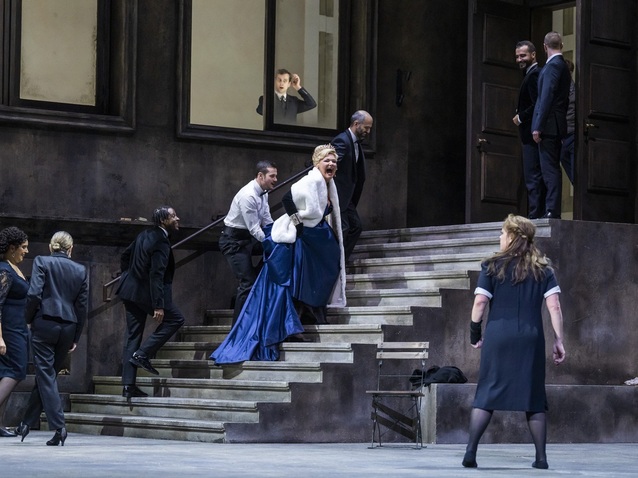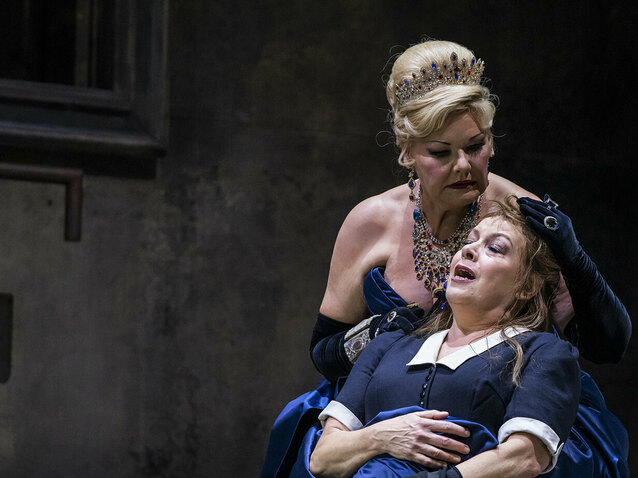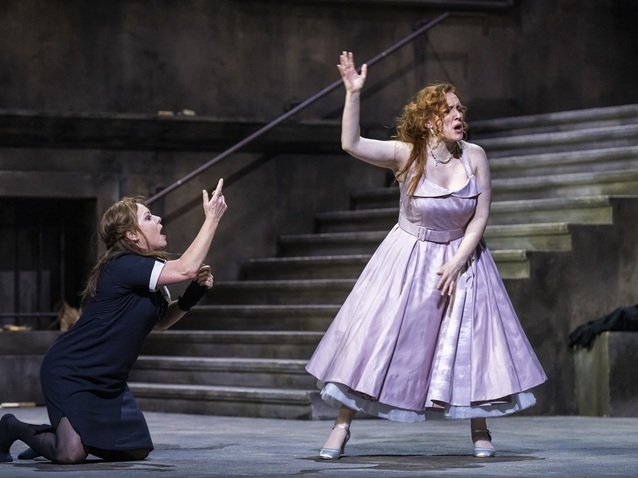 © ROH 2024, Photo by Tristram Kenton
© ROH 2024, Photo by Tristram Kenton
Based on the Sophocles tragedy, Richard Strauss’s Elektra of 1909 represents the first of his several collaborations with librettist Hugo von Hofmannsthal, who in this instance had already written an eponymous play. It is the second of Strauss’s two highly modernist operas, and deploys dissonance, chromaticism and extremely fluid tonality to an even greater degree than his first, Salome.
The opera is expressionistic in every sense since the adaptation of the story focuses very much on Elektra herself, and thus penetrates her character and psychology to a remarkable degree. The story takes place in the aftermath of the murder of Elektra’s father King Agamemnon by her mother Klytämnestra and her lover Ägisth. As Elektra seeks revenge on her father’s killers she feels totally isolated as Klytämnestra and Ägisth have shut her out, her sister Chrysothemis is seeking to escape the entire situation, and her brother Orest has been banished. Since the event that led Klytämnestra to murder Agamemnon, namely his killing of their daughter Iphigenia, is completely ignored, we are encouraged to see everything from Elektra’s perspective as the story predominantly comprises a series of one-to-one encounters between her and, in turn, Chrysothemis, Klytämnestra, Orest and Ägisth.
However, although the tight focus on Elektra is largely the making of the opera, the strength of Christof Loy’s new production for the Royal Opera is that it does full justice to all of the other characters as well. That this is the case is also a tribute to Nina Stemme’s central performance as Elektra because it takes more skill to allow every viewpoint to come to the fore than it does simply to act as the dominant force from start to finish. On occasions Stemme can actually feel like quite a quiet presence, and there are times when she sits or even kneels as the other character sings. However, this does not mean that her involvement in the scenes is ever less than total, and one can always detect the senses of determination and defiance in her mind.

Nina Stemme (Elektra), Karita Mattila (Klytämnestra) in Elektra © ROH 2024 Photo by Tristram Kenton
Elektra’s encounter with Klytämnestra (Karita Mattila) is quite lengthy and both Stemme and Mattila’s approach allows the scene to build at exactly the right pace to its overwhelming climax, as opposed to creating a highly charged atmosphere from the start that cannot then be sustained. The direction also aids the multifaceted approach as often the person singing gazes out, while the other stares at them either from behind or by turning around. The approach is practical in the sense that the characters need to face the front when they sing, but it ensures that the audience is always engaged both with the individual who is espousing their thoughts, and the encounter as a whole since the second figure never ceases to be fully involved in it.
Drawing on the architecture of Vienna at the start of the twentieth century, Johannes Leiacker’s set makes the palace in Mycenae feel austere and functional. We view it from its courtyard, but we can see through its windows that it possesses electric lights that illuminate an almost clinically bare interior. The courtyard itself reveals grubby exterior walls and rubbish left in alcoves, and herein we witness the contrast between society and nature. Inside the palace there is order as well as corruption, and Klytämnestra and Ägisth have allies and protection there. Elektra, on the other hand, is an outcast ‘confined’ to the courtyard, and hence only a breath away from the banished Orest who is (allegedly) keeping company with animals.
This sets up all sorts of juxtapositions as the climax to Elektra and Klytämnestra’s encounter takes place in the courtyard with the palace sealed off from them as all openings to it are shut. Under such circumstances, Klytämnestra has no protection from anyone and so feels highly vulnerable to Elektra’s attacks. At the end of the scene, the doors and windows swing open once more, the palace lights come on and the Trainbearer, Confidante and others appear, allowing Klytämnestra to retreat to safety. Quite how different the atmosphere feels in the space of a few seconds is illustrated by the fact that Klytämnestra, who was previously suffering the agony of hearing how she will die, now feels able to laugh at the ‘pathetic’ Elektra.

Nina Stemme (Elektra), Sara Jakubiak (Chrysothemis) in Elektra © ROH 2024. Photo by Tristram Kenton
The set comprises two high walls that meet at a diagonal in the middle. It cuts off much of the stage’s depth, forcing the action to the front and creating a suitably sized performance area for an opera whose focus is largely on key individuals. At the same time, the height to which the walls rise still makes the space feel quite large and intimidating, thus emphasising how small Elektra feels in the face of everything she is up against. Although she is outside the palace and hence society, the set also succeeds in suggesting she is enclosed and hence trapped in her situation when all of the doors and windows are shut. However, the balance that is achieved is highly important because the steps up to the palace door are taller than Stemme when she stands under them, thus emphasising the formidable nature of what Elektra has to confront, but not so large as to swamp her and make her feel too insignificant.
Nina Stemme brings total class to the role of Elektra with her soprano being extremely full, nuanced and impassioned. On opening night she did tire during her scene with Orest, when some coughing was noticeable, but this episode is unlikely to be repeated in future performances, and she recovered extremely well to deliver a thrilling climax. Karita Mattila is equally strong as Klytämnestra, with her own rich soprano proving perfectly suited to conveying both the character’s haughtiness and fear. Sara Jakubiak is brilliant as Chrysothemis as she reveals a perfectly controlled sound, masterly phrasing and a notable cleanness even when she is at full throttle. Łukasz Goliński displays a dark and extremely secure bass-baritone as Orest, while Charles Workman shines in the relatively small role of Ägisth. In his final season as its Music Director, Sir Antonio Pappano elicits a highly accomplished sound from the Orchestra of the Royal Opera House. While delineating a whole range of textures, nuances and details that are inherent in Strauss’s enigmatic score, his delivery still captures something of the visceral thrill that makes the evening feel undoubtedly powerful and intense.
By Sam Smith
Elektra | 12 - 30 January 2024 | Royal Opera House, Covent Garden
the 14 of January, 2024 | Print
Comments